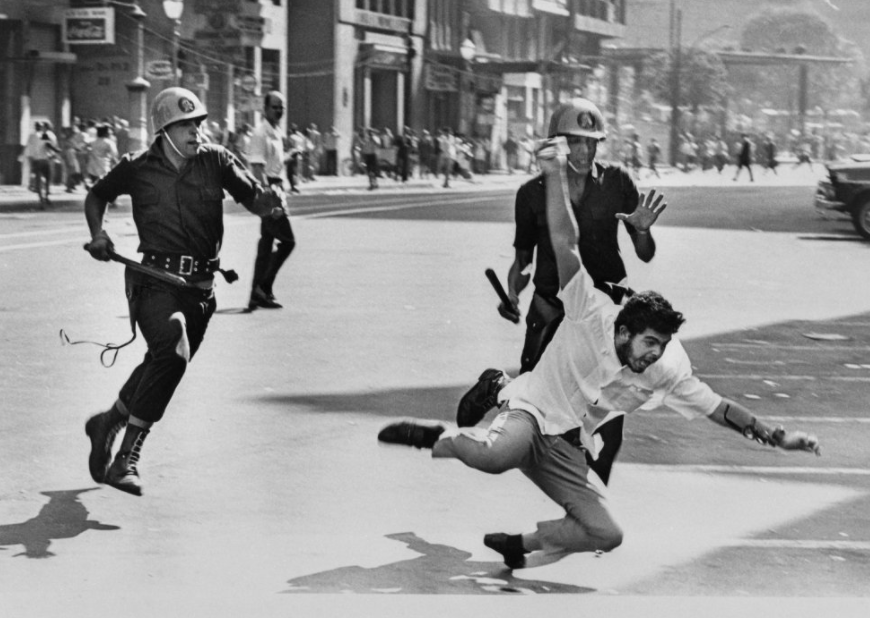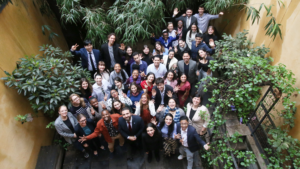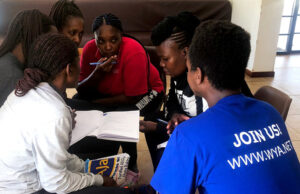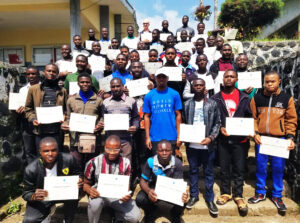[su_tabs active=”2″][su_tab title=”English”]
The Years of Lead: a Brazilian Trauma
The vulnerability of human rights in Brazil’s military dictatorship
The military dictatorship in Brazil is the consequence of political and economic crises, and it lasted between the years of 1964 and 1985. From the coup in Castelo Branco to the long re-democratization in João Figueiredo, Brazilian history acquires deep marks in national politics and in Human Rights. So, there are moments of greater hardening of authoritarianism, thus, the so-called “Years of Lead” points to the worst stage of national repression, between 1968 and 1974. Human rights violations permeate the practice of tortures, irregular arrests, murders, persecutions, in addition to the institutionalization of these violations. The Institutional Acts, the 1967 Constitution, mechanisms created in favor of repression, such as the Internal Operation Detachments (DOI) and the Internal Defense and Operations Centers (CODI), crystallize the violations of Human Rights that became legal during the period. In this sense, the Collective Security reasoning, which actually did not prioritize popular well-being, abused an exacerbated nationalism to control the population and to repress resistance movements, distorting human dignity.

Instead of the state apparatus protecting national security and looking for the interests of the people, it was captured to serve the military dictatorship, a regime in which the human person is no longer protected. Hannah Arendt (2011) points out that violence destroys power and distorts the notion of social cohesion, as social rights and freedom are not allowed to people. Thus, not all Brazilian people legitimize the regime’s authority, but they were repressed as much as possible in order to face all their rights restricted. In this sense, the Human Rights agenda in Brazil has come a long and difficult path after the dissolution of the military regime. The Amnesty Law (1979) leads to the silencing of human rights violations, since all crimes committed in the period were forgiven. The forgetfulness supported by the Amnesty Law is still a sequel for the victims, as Brazil becomes negligent with the crimes committed by dictators and their allies through this legal apparatus.
It is essential to relate how society needs to preserve the concepts that the World Youth Alliance defends, that human dignity must be the center of public policies and forms of government. From the Human Rights violations by an authority that should protect society, the nation ceases to be valued instead of being objectified by an oppressive power project. As the WYA Charter defends, there must be respect for the right to life in order for society to establish itself as fair and free. Therefore, we need to protect human dignity and resist the chaos of regimes that do not truly prioritize Collective Security. Brazil had to fight incessantly to survive this tough period. Although the resistance was not enough to prevent hundreds of people being murdered and thousands of people tortured, the strength of the movement allowed history not to be completely silenced.
[su_divider top=”no” size=”1″]
References:
ARENDT, Hannah. Sobre a violência. Rio de Janeiro: Editora Civilização Brasileira, 2011.
Para OAB, anistia a crime de tortura é inconstitucional. Agência Câmara de Notícias, 2013. Available in: https://www.camara.leg.br/noticias/403361-para-oab-anistia-a-crime-de-tortura-e-inconstitucional
Imagens da ditadura: registros de um outro tempo. El País Brasil, 2018. Available in: https://brasil.elpais.com/brasil/2018/11/22/album/1542923865_871951.html#foto_gal_4
“Os anos de chumbo”: livro relembra horrores da ditadura militar. Galileu, 2020. Available in: https://revistagalileu.globo.com/Sociedade/Historia/noticia/2020/03/os-anos-de-chumbo-livro-relembra-horrores-da-ditadura-militar.html
História da Ditadura. Memórias da ditadura. Available in: ttp://memoriasdaditadura.org.br/
Human Rights Watch: ditadura no Brasil torturou 20 mil pessoas; 434 foram mortas ou desapareceram. Estadão, 2019. Available in: https://politica.estadao.com.br/noticias/geral,human-rights-watch-ditadura-no-brasil-torturou-20-mil-pessoas-434-foram-mortas-ou-desapareceram,70002770377
[su_divider top=”no” size=”1″]
Published: November 12, 2021
Written by Anni Barreto, Project Management Intern for the World Youth Alliance Latin America.
[/su_tab]
[su_tab title=”Portuguese”]
Os Anos de Chumbo: um Trauma Brasileiro
A vulnerabilidade dos Direitos Humanos na ditadura militar no Brasil
A ditadura militar no Brasil decorreu de crises políticas e econômicas, perdurando entre os anos de 1964 e 1985. Desde o golpe em Castelo Branco até a longa redemocratização em João Figueiredo, a história brasileira adquire marcas profundas na política nacional e nos Direitos Humanos. Durante o regime, há momentos de endurecimento do autoritarismo, assim, o chamado “Anos de Chumbo” aponta para o pior estágio da repressão nacional, entre 1968 e 1974. As violações aos Direitos Humanos perpassam as práticas de torturas, prisões irregulares, assassinatos, perseguições, para além disso, a institucionalização dessas violações. Os Atos Institucionais, a Constituição de 1967, os órgãos criados em prol da repressão, como o Destacamentos de Operação Interna (DOI) e os Centros de Operações e Defesa Interna (CODI), cristalizam as violações dos Direitos Humanos transitadas para a legalidade. Nesse sentido, a retórica da Segurança Coletiva, que na verdade não priorizava o bem estar popular, abusava de um nacionalismo exacerbado para controlar a população e reprimir os movimentos de resistência, deturpando a dignidade humana.

Ao invés do aparelho estatal ser o protetor da segurança nacional e dos interesses do povo, passou a ser capturado para servir à ditadura militar, um regime em que a pessoa humana não é mais protegida. Hannah Arendt (2011) aponta que a violência destrói o poder e deturpa a noção de coesão social, já que os direitos sociais e a própria liberdade da população não são permitidos. Logo, nem toda a sociedade brasileira legitima a autoridade do regime, mas é reprimida ao máximo e tem todos os seus direitos enxugados. Diante disso, a pauta dos Direitos Humanos no Brasil percorre um caminho longo e difícil após o regime militar se dissolver. A partir da Lei da Anistia (1979), todos os crimes cometidos no período eram perdoados, o que gera o silenciamento das violações dos Direitos Humanos. O esquecimento amparado pela Lei da Anistia ainda é uma sequela para as vítimas injustiçadas, visto que o Brasil torna-se negligente com os crimes cometidos pelos ditadores e seus aliados através desse aparato jurídico.
É importante relacionar como uma sociedade precisa preservar os preceitos que a World Youth Alliance defende, que a dignidade humana deve ser o centro de políticas públicas e de formas de governo. A partir da violação dos Direitos Humanos por uma autoridade que deveria proteger a sociedade, a nação deixa de ser valorizada e é objetificada por um projeto de poder opressor. Como defende a Carta da WYA, para uma sociedade ser justa e livre, é preciso que haja o respeito pelo direito à vida, por isso, a sociedade precisa proteger a dignidade humana e resistir ao caos de regimes que não priorizam a Segurança Coletiva de fato. O Brasil precisou lutar incessantemente para sobreviver ao período, a resistência não foi suficiente para evitar centenas de pessoas assassinadas e milhares de pessoas torturadas, mas a força do movimento permitiu que a história não fosse totalmente silenciada.
[su_divider top=”no” size=”1″]
Referências:
ARENDT, Hannah. Sobre a violência. Rio de Janeiro: Editora Civilização Brasileira, 2011.
Para OAB, anistia a crime de tortura é inconstitucional. Agência Câmara de Notícias, 2013. Disponível em: https://www.camara.leg.br/noticias/403361-para-oab-anistia-a-crime-de-tortura-e-inconstitucional
Imagens da ditadura: registros de um outro tempo. El País Brasil, 2018. Disponível em: https://brasil.elpais.com/brasil/2018/11/22/album/1542923865_871951.html#foto_gal_4
“Os anos de chumbo”: livro relembra horrores da ditadura militar. Galileu, 2020. Disponível em: https://revistagalileu.globo.com/Sociedade/Historia/noticia/2020/03/os-anos-de-chumbo-livro-relembra-horrores-da-ditadura-militar.html
História da Ditadura. Memórias da ditadura. Disponível em: http://memoriasdaditadura.org.br/
Human Rights Watch: ditadura no Brasil torturou 20 mil pessoas; 434 foram mortas ou desapareceram. Estadão, 2019. Disponível em: https://politica.estadao.com.br/noticias/geral,human-rights-watch-ditadura-no-brasil-torturou-20-mil-pessoas-434-foram-mortas-ou-desapareceram,70002770377
[su_divider top=”no” size=”1″]
Publicado: 12 de novembro de 2021
Escrito por: Anni Barreto, Estagiária de Gestão de Projetos da World Youth Alliance América Latina
[/su_tab] [/su_tabs]







